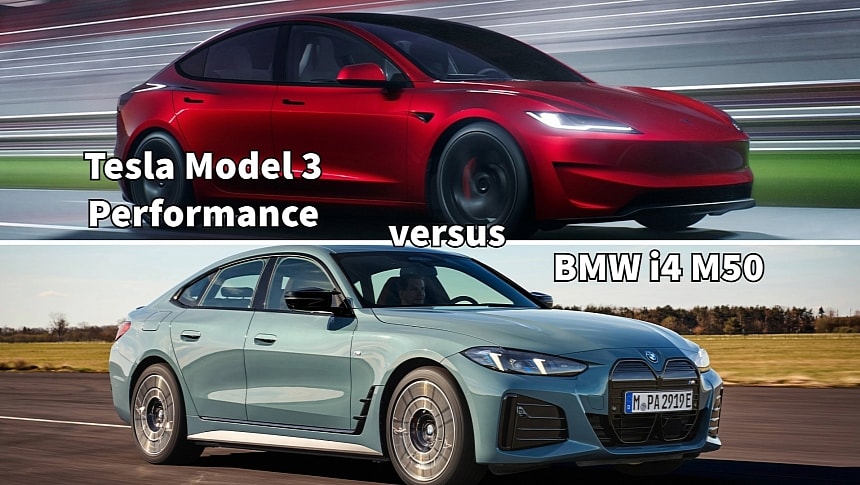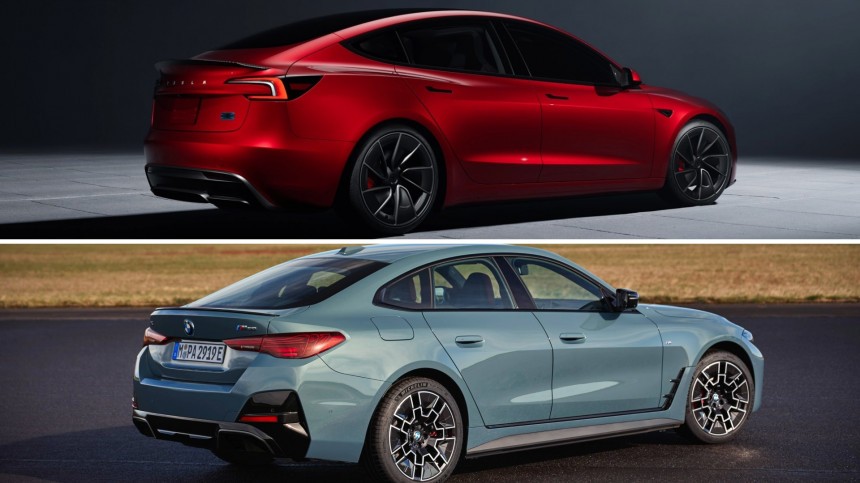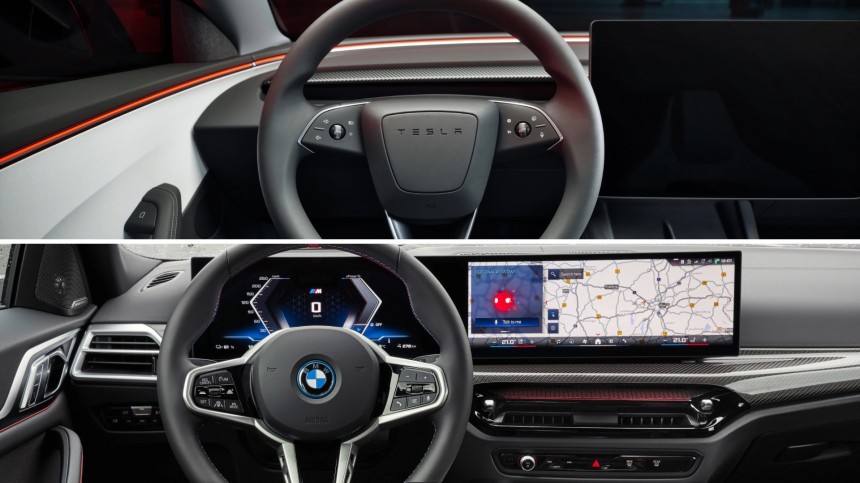Tesla upped the ante with the refreshed Model 3 Performance, which many believe was worth the wait. The electric performance sedan is more refined and competent, offering many enhancements that make it a worthy rival to the best BMW has to offer. People who tested the Model 3 Performance claim it is better than the BMW i4 M50 and even the gas-powered BMW M3, so here's what you need to know.
Tesla Model 3 Performance was never a thoroughbred racer, but a fast electric vehicle sold at a competitive price. Of course, it was fast, thanks to its powerful electric drivetrain, but it had nothing special compared to the regular versions of the Model 3. Daniel Ho, Tesla's director for Vehicle Programs and New Product Introduction (NPI), explained last year that the first Model 3 Performance was rushed to the market in 2017. This means that Tesla left a lot on the table regarding performance.
The EV maker corrected this mistake with the second generation of the Model 3, fondly named "Highland." This time, Tesla took its time, which delayed the Model 3 Performance launch. The refreshed Model 3 started deliveries in September 2023 in Europe and Asia, with North America following in January 2024. For three months, only the RWD and LR AWD variants were available to order.
Tesla officially launched the Model 3 Performance on April 23, on the day of the Q1 2024 earnings call. The aggressive design and all other Highland upgrades already made the Model 3 Performance better than its predecessor. However, Tesla ensured it didn't leave things on the table this time. The refreshed Model 3 Performance features 4th generation drive units, which are both more powerful and efficient. It also has an adaptive suspension for the first time, alongside higher performance brakes, improved chassis, and better aerodynamics.
The changes Tesla made to the Model 3 Performance made it a much better sports car than its predecessor. The top speed improved slightly (163 mph/262 kph versus 162 mph/261 kph), but 0-60 acceleration time dropped from 3.1 seconds to 2.9 seconds with rollout subtracted. This might not seem like much, but every tenth-of-a-second improvement requires huge efforts at this level. Although not important for a sportscar, Tesla also improved the range, from 284 miles previously to 296 miles. This is even more impressive considering the stricter EPA testing methods.
There's only one caveat, though: the different power levels advertised for vehicles produced at Giga Shanghai and those from Fremont. The former are sold in Europe, most of Asia, and (somehow surprisingly) Canada. On the other hand, the US model is only sold in the US, as Tesla wants to prioritize the locally produced battery cells for the IRA tax credit.
The made-in-China M3P features an LG battery pack with a lower power limit (415 kW versus 435 kW) than the Panasonic-made pack of the American-made Model 3 Performance. This is why Tesla also limited the peak power to 460 horsepower instead of 510 horsepower. However, the performance remained comparable, with the same top speed and roughly equivalent acceleration times (the European model advertises 3.1 seconds but for the 0-100 kph/62 mph time).
The refreshed Tesla Model 3 Performance is still an accomplished sports car regardless of the manufacturing location. Those who got to test it compared it to the BMW M3 to the point that they no longer consider the German sports car the segment's benchmark. Even on paper, the Model 3 Performance trumps the M3 Competition xDrive, which needs 3.4 seconds to reach 60 mph from a standstill.
The BMW M3 costs $84,300, $30K more than Tesla's athlete. The lesser M3 variants (which are not much cheaper anyway) are rear-wheel drive only and can't hold a candle to the Tesla Model 3 Performance. Of course, we haven't seen the latter on a racetrack yet, so we'll hold off on the verdict. The Track Mode V3 will also have to prove its worth by then.
For a like-for-like comparison, I believe an electric rival from BMW's stable, like the i4 M50, is a better fit. Recently refreshed (although the LCI model is not yet available), the BMW i4 M50 is surprisingly the M division's best-selling model. However, that's warranted, considering that it packs more power in an AWD configuration (536 horsepower versus M3's 503 horsepower) for $14,300 less.
The BMW i4 M50 looks like a winner on paper, even compared to the Tesla Model 3 Performance, but one important detail holds it back. The electric M sedan is much heavier, affecting performance and efficiency (BMW i4 M50 has a maximum range of 269 miles/433 km). The Tesla Model 3 Performance weighs 4,054 lbs. (1,840 kg), almost like the BMW M3 (3,990 lbs./1,810 kg). The BMW i4 M50, on the other hand, tips the scales at 5,018 lbs. (2,275 kg).
This is why the BMW i4 turns out slower regarding both top speed and acceleration. The electric Bimmer has a top speed limited to 130 mph (209 kph), which is shameful for a sports car. Its gas-powered brother can go to 155 mph (249 kph) but can be unlocked to reach 180 mph (290 kph). Meanwhile, the Tesla Model 3 Performance can reach a top speed of 163 mph (262 kph) from the factory. Considering that the Tesla sedan starts at $52,990 (or $45,490, including the Federal EV credit), it's hard to recommend the BMW i4.
BMW fans might want to point out that BMW's build quality and materials are much better. However, Tesla has improved a lot in this area, and the Model 3 Performance pampers its occupants with premium materials, including carbon fiber details and ventilated sports seats that offer improved lateral support for cornering and dynamic driving.
The EV maker corrected this mistake with the second generation of the Model 3, fondly named "Highland." This time, Tesla took its time, which delayed the Model 3 Performance launch. The refreshed Model 3 started deliveries in September 2023 in Europe and Asia, with North America following in January 2024. For three months, only the RWD and LR AWD variants were available to order.
Tesla officially launched the Model 3 Performance on April 23, on the day of the Q1 2024 earnings call. The aggressive design and all other Highland upgrades already made the Model 3 Performance better than its predecessor. However, Tesla ensured it didn't leave things on the table this time. The refreshed Model 3 Performance features 4th generation drive units, which are both more powerful and efficient. It also has an adaptive suspension for the first time, alongside higher performance brakes, improved chassis, and better aerodynamics.
The changes Tesla made to the Model 3 Performance made it a much better sports car than its predecessor. The top speed improved slightly (163 mph/262 kph versus 162 mph/261 kph), but 0-60 acceleration time dropped from 3.1 seconds to 2.9 seconds with rollout subtracted. This might not seem like much, but every tenth-of-a-second improvement requires huge efforts at this level. Although not important for a sportscar, Tesla also improved the range, from 284 miles previously to 296 miles. This is even more impressive considering the stricter EPA testing methods.
The made-in-China M3P features an LG battery pack with a lower power limit (415 kW versus 435 kW) than the Panasonic-made pack of the American-made Model 3 Performance. This is why Tesla also limited the peak power to 460 horsepower instead of 510 horsepower. However, the performance remained comparable, with the same top speed and roughly equivalent acceleration times (the European model advertises 3.1 seconds but for the 0-100 kph/62 mph time).
The refreshed Tesla Model 3 Performance is still an accomplished sports car regardless of the manufacturing location. Those who got to test it compared it to the BMW M3 to the point that they no longer consider the German sports car the segment's benchmark. Even on paper, the Model 3 Performance trumps the M3 Competition xDrive, which needs 3.4 seconds to reach 60 mph from a standstill.
The BMW M3 costs $84,300, $30K more than Tesla's athlete. The lesser M3 variants (which are not much cheaper anyway) are rear-wheel drive only and can't hold a candle to the Tesla Model 3 Performance. Of course, we haven't seen the latter on a racetrack yet, so we'll hold off on the verdict. The Track Mode V3 will also have to prove its worth by then.
The BMW i4 M50 looks like a winner on paper, even compared to the Tesla Model 3 Performance, but one important detail holds it back. The electric M sedan is much heavier, affecting performance and efficiency (BMW i4 M50 has a maximum range of 269 miles/433 km). The Tesla Model 3 Performance weighs 4,054 lbs. (1,840 kg), almost like the BMW M3 (3,990 lbs./1,810 kg). The BMW i4 M50, on the other hand, tips the scales at 5,018 lbs. (2,275 kg).
This is why the BMW i4 turns out slower regarding both top speed and acceleration. The electric Bimmer has a top speed limited to 130 mph (209 kph), which is shameful for a sports car. Its gas-powered brother can go to 155 mph (249 kph) but can be unlocked to reach 180 mph (290 kph). Meanwhile, the Tesla Model 3 Performance can reach a top speed of 163 mph (262 kph) from the factory. Considering that the Tesla sedan starts at $52,990 (or $45,490, including the Federal EV credit), it's hard to recommend the BMW i4.
BMW fans might want to point out that BMW's build quality and materials are much better. However, Tesla has improved a lot in this area, and the Model 3 Performance pampers its occupants with premium materials, including carbon fiber details and ventilated sports seats that offer improved lateral support for cornering and dynamic driving.
















































